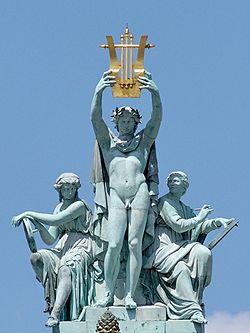
Aimé Millet
Encyclopedia

Millet was the son of miniaturist Frederick Millet (1796-1859) and uncle to Chicago
Chicago
Chicago is the largest city in the US state of Illinois. With nearly 2.7 million residents, it is the most populous city in the Midwestern United States and the third most populous in the US, after New York City and Los Angeles...
architectural decorator Julian Louis Millet (1856-1923). He studied and made first in 1836 at the École des Beaux Arts with David d'Angers and Viollet-le-Duc, who was later to design the base of Millet's statue of Vercingetorix
Vercingetorix
Vercingetorix was the chieftain of the Arverni tribe, who united the Gauls in an ultimately unsuccessful revolt against Roman forces during the last phase of Julius Caesar's Gallic Wars....
in Alesia
Alesia
-Places:France*Alesia , an ancient city in Gaul**Battle of Alesia*Alésia , a station in the Paris Métro*Rue d'Alésia, Paris*Le quartier Alésia, an unofficial district of Paris that mostly overlaps Petit-MontrougeUnited States...
.
In 1840 Millet began to produce his early works, in 1859 received the Légion d'honneur
Légion d'honneur
The Legion of Honour, or in full the National Order of the Legion of Honour is a French order established by Napoleon Bonaparte, First Consul of the Consulat which succeeded to the First Republic, on 19 May 1802...
, and in February 1870 was appointed professor at the École des Arts décoratifs
École nationale supérieure des arts décoratifs
The École Nationale Supérieure des Arts Décoratifs is a public university of art and design and is one of the most prestigious French grande école...
. He was a friend of sculptor Pierre Louis Rouillard
Pierre Louis Rouillard
Pierre Louis Rouillard was a French sculptor known for his sculptures of animals. He was one of a "school of French animalières" which also included Pierre-Jules Mêne, Antoine-Louis Barye, Auguste Caïn and François Pompon...
and his students included Louis Majorelle
Louis Majorelle
Louis-Jean-Sylvestre Majorelle, usually known simply as Louis Majorelle, was a French decorator and furniture designer who manufactured his own designs, in the French tradition of the ébéniste...
, Berthe Morisot
Berthe Morisot
Berthe Morisot was a painter and a member of the circle of painters in Paris who became known as the Impressionists. She was described by Gustave Geffroy in 1894 as one of "les trois grandes dames" of Impressionism alongside Marie Bracquemond and Mary Cassatt.In 1864, she exhibited for the first...
, and François Pompon
François Pompon
François Pompon was a French sculptor and animalier.Born in Saulieu in Burgundy, he moved to Paris. Beginning in 1870 he studied under the noted animalier Pierre Louis Rouillard at the École nationale supérieure des arts décoratifs, and later worked as Auguste Rodin's assistant...
.
Millet died in Paris on January 14, 1891, and is buried in Montmartre Cemetery
Montmartre Cemetery
Montmartre Cemetery is a cemetery in the 18th arrondissement of Paris, France.-History:Cemeteries had been banned from Paris since the shutting down of the Cimetière des Innocents in 1786, as they presented health hazards...
.
Selected works
- The monumental statue of VercingetorixVercingetorixVercingetorix was the chieftain of the Arverni tribe, who united the Gauls in an ultimately unsuccessful revolt against Roman forces during the last phase of Julius Caesar's Gallic Wars....
, ordered by Napoleon III, built on site in Alesia. - Apollo, Poetry, and Music, on Paris OpéraPalais GarnierThe Palais Garnier, , is an elegant 1,979-seat opera house, which was built from 1861 to 1875 for the Paris Opera. It was originally called the Salle des Capucines because of its location on the Boulevard des Capucines in the 9th arrondissement of Paris, but soon became known as the Palais Garnier...
roof, between 1860-1869 - François-René de ChateaubriandFrançois-René de ChateaubriandFrançois-René, vicomte de Chateaubriand was a French writer, politician, diplomat and historian. He is considered the founder of Romanticism in French literature.-Early life and exile:...
, bronze statue, Saint Malo, 1875 - Cassandre se met sous la protection de Pallas, Jardin des Tuileries, 1877
- South America, one of six cast iron allegories of the continents, built for the Exposition Universelle (1878)Exposition Universelle (1878)The third Paris World's Fair, called an Exposition Universelle in French, was held from 1 May through to 10 November 1878. It celebrated the recovery of France after the 1870 Franco-Prussian War.-Construction:...
, currently on the square of the Musée d'OrsayMusée d'OrsayThe Musée d'Orsay is a museum in Paris, France, on the left bank of the Seine. It is housed in the former Gare d'Orsay, an impressive Beaux-Arts railway station built between 1898 and 1900. The museum holds mainly French art dating from 1848 to 1915, including paintings, sculptures, furniture,... - PhidiasPhidiasPhidias or the great Pheidias , was a Greek sculptor, painter and architect, who lived in the 5th century BC, and is commonly regarded as one of the greatest of all sculptors of Classical Greece: Phidias' Statue of Zeus at Olympia was one of the Seven Wonders of the Ancient World...
at the Jardin du LuxembourgJardin du LuxembourgThe Jardin du Luxembourg, or the Luxembourg Gardens, is the second largest public park in Paris The Jardin du Luxembourg, or the Luxembourg Gardens, is the second largest public park in Paris The Jardin du Luxembourg, or the Luxembourg Gardens, is the second largest public park in Paris (224,500 m²...
, Paris, 1887

